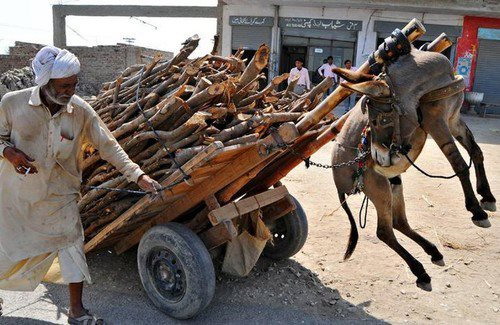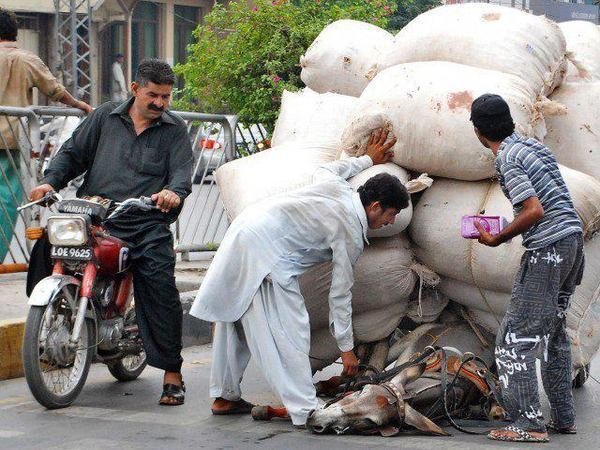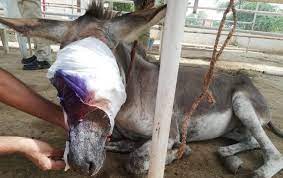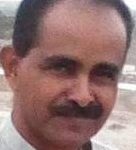
Domestic animals including equines’ contribution in livelihood of laborers, rural agriculture and many other fields is paramount.
Gulsher Panhwer
After agriculture, livestock is second major source of livelihood for majority of rural population in Pakistan. The livestock also contributes fairly in several industries and by-products of milk, leather and animal-sourced food is also one of the important source of livelihood and diversified food source and meets rich nutrition needs of the population. Equines, also called beasts of burden help in making the lives easier of their owners and contribute immensely in the economy of the country but callousness against these animals is disgraceful.
In majority cases Buffalo and cows are given injection twice or thrice a day to extract as much milk as possible. This makes milk piousness and causes injury to the poor animals. Further on ever increasing commercial dairy farms, young ones of the buffaloes and cows are separated from their mothers and sold to the butchers so that the greedy dairy farmers can extract maximum profit. The heart comes to mouth when one sees, these young ones aging barley weeks to be bundled in trucks and pickups to slaughter house. In other cases young ones are pulled back after few suckles and soon as the mother cow or buffalo lifts her milk, the young one is abruptly pulled back. This is robbery on the right of the young to its mother’s milk
But the state of the equines including horses, mules and donkeys used by cart runners, mountaineers or hawkers is also most miserable.
Besides Travelers and tourists in mountain and desert areas, gypsy families also use donkeys, camels and mules for taking load or travelers on these beasts of burden where no other mode of transport is feasible. As water and fodder is not available for long distances in these desert or mountainous areas, the poor animals trudge difficult treks for days without rest and without water and fodder. The heavy load, high climbs and ropes tied around the belly and round the back legs cut badly these hungry and exhausted animals. Their backs get wounded due to continuous load laden on them.
The donkey is also used in taking kacha (unbaked) and baked bricks. A group of 10 to 15 donkeys are controlled by a man called Daio in local language. The Daio mounting on one of sturdy donkey, drives the herd of donkey to the brick kiln or kacha brick-making point. He uses stick to keep the group of the donkeys on trek and making them run as fast as possible with the load of 30 or more bricks on the back of each donkey. The plight of these brick transporting donkeys is pitiable. Their nostrils wide open and their loud groans make the coldest heart to melt.
 The hard-hearted Daio hardly cares for watering or giving a break to the animals under his care. In scorching heat of summer, he leads them in the midday to the watering points, usually a polluted pond but if the target is high he skips watering of midday to evening.
The hard-hearted Daio hardly cares for watering or giving a break to the animals under his care. In scorching heat of summer, he leads them in the midday to the watering points, usually a polluted pond but if the target is high he skips watering of midday to evening.
Most of these animals are bleeding from almost all major parts of their bodies. Back due to taking heavy load, back parts of legs due to tight rope cuts and so on.
When these wounds widen and become incurable sores such donkeys are left to fend in streets and on roads and die a painful death caused due wounds accompanied by hunger and thirst. In rural areas, there are no animal dispensaries but wherever available, the owners feels shame to take the donkey for treatment and similarly, majority of the vets deems it lower to their “self-esteem” to treat equine, especially donkey.
Mostly the Oad community works for making kacha homes in rural parts of Sindh. They use donkeys to carry raw mud soil to make compound walls, rooms and sheds. The fate of poor animals used by Oads is similar to be used in taking bricks.
The donkeys are also widely used in donkey carts for multipurpose tasks – for transporting goods in long and short distances. The donkeys in this category are not properly watered or fed. They stand in open sun in sizzling summer, the ‘senaband’ (a cloth made strip around their chest for pulling the cart) makes them strangle during standing as well as during dragging the cart. The rope around their back legs, working as break, used for halting or slowing the carts, cuts badly. The cart runner pocks pointed stick in the wound of the animal to make the animal run faster. The payti rope (a rope tied around their belly used for balancing the cart load) also cuts badly and in case of inexperienced cart diver makes the animal hang in the air when load is shifted backward in the cart. Or when load shifts forwards, the poor animal falls flat on the road, with heavy load crushing it under heavy weight, the break rope becomes extremely tightened cutting baldy and the ‘sena band’ strangling it extremely at the same time. This is most cruel spectacle when the donkey in the cart hangs or falls forward.
Still in some villages the households use donkey for grinding flour in small grinding stone. The donkey with its eyes tied continues to run the grind stone for whole day and even during whole day and night. When it halts due to exhaustion, hunger or thirst, the stick bearing family members beats the beast to run. The donkey used in grinding flour is not better than the animals used in different occupation as mentioned above.
 A significant number of the poorest of poor also earn their livelihood by selling vegetables, fruits, and fish in the villages. They use donkey for this purpose. They sell their articles on cash but as in rural parts, cash is rarely with women, hawker has to mostly sell things to women in exchanges of food grain, iron scrape or stale dry particles of the residue food. Thus, the animals have to bear load of three kinds, the article for sell put into khurzeen (the hanging sack when put on the back of the donkey, mule or horse hangs on both sides with open parts on both sides to put different things and scale, measuring stones etc.), the hawkers mounting over the Khurzeen and afterwards during sell of the things, grain or other articles got in exchange from village to village are also loaded on the animals back. As hawkers take the animal early in the morning and return after sunset as they have to go to sell their things in very remote villages, animal have to bear threefold burden for whole day. The back of the donkey is wounded; back legs cut with ropes such animals always remains in miserable state.
A significant number of the poorest of poor also earn their livelihood by selling vegetables, fruits, and fish in the villages. They use donkey for this purpose. They sell their articles on cash but as in rural parts, cash is rarely with women, hawker has to mostly sell things to women in exchanges of food grain, iron scrape or stale dry particles of the residue food. Thus, the animals have to bear load of three kinds, the article for sell put into khurzeen (the hanging sack when put on the back of the donkey, mule or horse hangs on both sides with open parts on both sides to put different things and scale, measuring stones etc.), the hawkers mounting over the Khurzeen and afterwards during sell of the things, grain or other articles got in exchange from village to village are also loaded on the animals back. As hawkers take the animal early in the morning and return after sunset as they have to go to sell their things in very remote villages, animal have to bear threefold burden for whole day. The back of the donkey is wounded; back legs cut with ropes such animals always remains in miserable state.
The livestock and equine play very important role in making the lives of their owners easier in several ways. Domestic animals including equines’ contribution in livelihood of laborers, rural agriculture and many other fields is paramount. But what this benign animal gets for its service is neglect, thirst, and hunger, overload, and curl methods of hitting, discrimination in feeding watering and care in comparison of other animals.
There is need for changing our attitudes against these voiceless and neglected and brutalized animals by its owners, vets and society at large.
_________________
 Gulsher Panhwer is a freelance writer mostly touching the environmental, cultural and such other issues. He can be reached at gulsherp@yahoo.com
Gulsher Panhwer is a freelance writer mostly touching the environmental, cultural and such other issues. He can be reached at gulsherp@yahoo.com